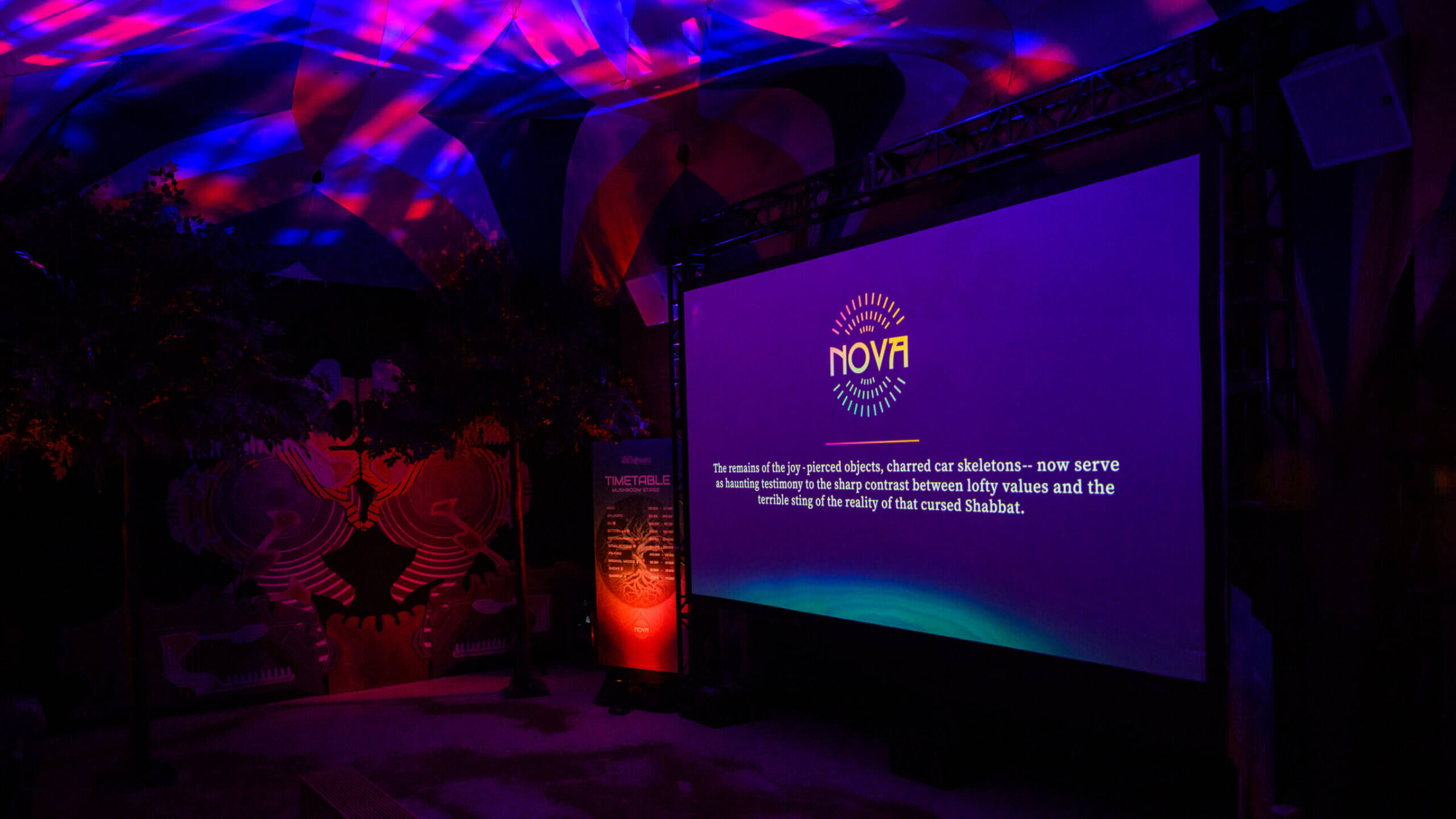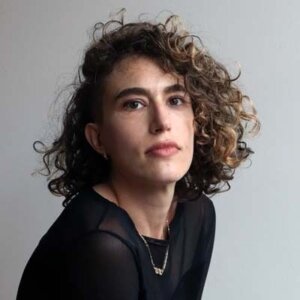‘I wouldn’t be here if I didn’t believe people could choose peace’: A Nova survivor on protests of Manhattan exhibit
Oct. 7 survivor Eilat Tibi came to New York to share her story — and experienced antisemitism for the first time

A screen displays info about the Nova festival at The Nova Music Festival Exhibition: October 7th 06:29 AM, The Moment Music Stood Still. Photo by Alexi Rosenfeld/Getty Images for The Nova Music Festival Exhibition
After anti-Israel activists descended upon an exhibition commemorating the victims of the Nova festival massacre earlier this week, one survivor, Eilat Tibi, was taken back to the early, terrifying days surrounding the Oct. 7 Hamas attack in southern Israel.
The Lower Manhattan exhibition space hosting October 7th / 6:29 am: The Moment Music Stood Still was one of many stops included on a so-called “Day of Rage” protest, organized by the pro-Palestinian group Within Our Lifetime. Protesters chanted “Zionists are not Jews and humans,” with some carrying Hamas and Hezbollah flags; at least one displayed a banner saying “Long live Oct. 7.”
“I don’t think they understand they are a pro-terror protest, outside a memorial of people who died by terror,” Tibi told me.
The exhibition originally premiered in Tel Aviv, where it was open to the public for 10 weeks. Now in New York City in a sprawling 50,000-square-foot venue on Wall Street, the exhibition was extended after Monday night’s protests until June 22.
Tibi, 34, has been in New York since April to give testimony at the exhibit. On Oct. 7, after fleeing the Nova Festival for two hours through fields of dead bodies, surrounded by gunfire and with rockets overhead, she ultimately found shelter in a stranger’s car with six other people.
In the immediate aftermath of the attack, the former assistant to the deputy mayor of Tel Aviv wouldn’t speak about what she’d experienced, feeling that since she had “only” been running for her life for two hours — she hadn’t been killed or kidnapped — she wasn’t really a survivor. She’d only gotten lucky. On Oct. 8, Tibi rejoined her air force unit in the reserves.
Gradually, with the help of the Tribe of Nova Foundation — a support group set up in the immediate aftermath of Oct. 7 by Nova survivors, for which Tibi is now the resource development coordinator — she found that by telling her story, she was able to heal.
I spoke with Tibi two days after the protest outside the Nova exhibit. Our conversation has been edited for length and clarity.
What happened on Monday night when the Day of Rage protesters arrived?
I had left the exhibit and was on my way back, but people there called and told me, “Don’t come back, it’s too unsafe.” They also told me not to go to our hotel, as they feared that protesters would follow me there.
When the protesters arrived, almost 200 people were inside listening to two survivors giving testimony. They started to hear the noise of the crowd, the smoke bombs, their chants. The noise outside was really triggering for them, as they’re in the middle of opening their own trauma and telling people what happened to them. They kept going until the protesters got too loud and the manager of the exhibition told them they needed to stop, and told everyone it wasn’t safe to leave. The NYPD came, and our own security, but it took a long time for people to be able to leave.
How soon after Oct. 7 were you able to talk about what you had survived?
On Oct. 7, by 8:30 a.m. I was out of the war zone. When you compare it to other people, I was out really fast. All of my friends got out, and all three of my cousins, we survived. By Oct. 8 I was already back in my unit, and I felt like I had no right to talk about being there. It was only two weeks later when a friend of mine was talking to me, and assumed I had left the festival early at 5 a.m. before the attack, that I started telling people that I had been there.
Immediately after the attack, the producers of Nova realized that we were 3,500-something survivors without a community or organization. Two days after Oct. 7, they had a community space for us, with healers and therapists and food and arts and crafts. Talking to other survivors there really helped me, but it still took me about two months before I could recreate that day fully and tell my story.
When did you realize that you wanted to be more public about your experience?
Talking to other survivors and telling my story over and over reduced the nightmares. It helped me sleep at night. It helped me to speak fluently about the day without crying, without blackouts. The images of the day would come back to me and I wouldn’t be as traumatized. After six months of the war, I was discharged from reserve duty, and I had quit my job. I immediately wanted to be part of the exhibition when I heard it was going to New York.
Protest organizer Nerdeen Kiswani of Within Our Lifetime wrote on X that she considered the Nova festival to be “a rave next to a concentration camp,” adding, “The exhibit at 35 Wall Street in NYC is propaganda used to justify the genocide in Palestine.” What does that statement mean to you?
I can’t be serious about what she’s saying, because she didn’t come inside. We’re calling it an exhibition, but this is a memorial. It’s a testimony to the victims and to the survivors. We’ve been open for a month and a half. If she wants to come inside, be part of it, meet with us survivors and really talk to us, and then she says things like that, I’ll address them seriously.
On the first day of the exhibition, there was a small, silent protest outside. We invited them in to see the exhibit and to talk with us, and they didn’t want to. They didn’t come in.
I believe in common good. I believe that for most of these protesters, they don’t want to see innocent people die in Gaza or in Israel. But if you really believe that you don’t want to see innocent people die, you need to choose an appropriate action.
I’ve only been in the States for two months, and it’s the first time I’ve understood or felt antisemitism, seeing these protests. I was shocked by the slogans they shouted.
This exhibit is not political. It’s about love and peace and all of these beautiful things that were stopped at 6:29 a.m. on Oct. 7 by terror. We want people to come to the exhibit so this kind of terror won’t happen again anywhere in the world, not just Israel. If you come and see the exhibit, you realize it’s not about choosing a side. It’s a story of people that got killed, and people who almost got killed, by terror. I wouldn’t be here on my own, away from my family, telling my story over and over, if I didn’t believe that people can choose peace, if I didn’t believe that there can be peace in the Middle East.
What has surprised you the most about the exhibition?
Meeting so many 9/11 survivors and seeing how much we have in common. After giving my testimony, a whole family of 9/11 survivors came up to me to talk about their experience. We have a lot in common as survivors of a terrorist attack, but also things that we don’t share. They were alone with their trauma for a lot longer, because it was the first time America had ever had something like that happen here. As Israelis, we knew immediately we needed a community. We have the knowledge in Israel of how to deal with PTSD. One of the 9/11 survivors told me, “What I did in 10 years to recover from my trauma, you did in six months.”
The other thing that’s surprised me the most is the antisemitism. As a Jew who lives in Israel, I had never felt it before. Coming to the States made me realize that Jews in the diaspora live with it all the time — sometimes it’s more intense, other times less. I realized that we’re all connected, that Israelis need diaspora Jews. We depend on each other. Many people who’ve worked in international Jewish organizations I’m sure have known this for years and years, but this is the first time that I understood that.
We’ve been using the term “survivor” a lot, and I can’t help but think of how it’s typically used in the Jewish community to refer to someone who has survived the Holocaust. It must be a little surreal to be a part of that lineage of Jewish survivors, even though Oct. 7 was very different from the Holocaust.
A lot of people compare Oct. 7 to the Holocaust because the evil we saw on Oct. 7 was the first time seeing it since the Holocaust. I don’t compare myself though because I have a family and a unit, and a country and an army and an international community that I am in relation with, that is supporting me. I have the privilege to defend my country after surviving the most horrific terror attack in Israel. We also, as Nova survivors, began talking about it as soon as we survived it with no shame, which is different from many survivors of the Shoah, who often didn’t want to talk about it.
Initially I didn’t like to use the word “survivor,” but after a couple of months, I realized that in order to move forward, I needed to accept that I am a survivor of a terror attack and accept what happened to me that day. Calling myself a survivor gave me permission to live my life.
There are two words for “survivor” in Hebrew: nitzol and sored. Nitzol is someone who was saved by chance. A sored is someone who made it out of there. The last five or six years in Israel, we’ve stopped calling survivors nitzolei Shoah and switched to soredei Shoah. Using sored, you’re giving a survivor credit, giving her power and agency in saving herself. It’s telling someone, “you’re brave for going through that, and you will recover eventually.”
A message from our Publisher & CEO Rachel Fishman Feddersen

I hope you appreciated this article. Before you go, I’d like to ask you to please support the Forward’s award-winning, nonprofit journalism so that we can be prepared for whatever news 2025 brings.
At a time when other newsrooms are closing or cutting back, the Forward has removed its paywall and invested additional resources to report on the ground from Israel and around the U.S. on the impact of the war, rising antisemitism and polarized discourse.
Readers like you make it all possible. Support our work by becoming a Forward Member and connect with our journalism and your community.
— Rachel Fishman Feddersen, Publisher and CEO




























